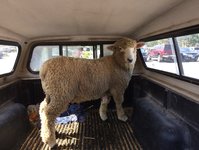 George on his way to his new home
George on his way to his new home Dear readers- My apologies for being so delinquent in my blog updates. It was a jam packed summer, and apparently Fall has gone by in the blink of an eye as Winter is now descending on us in the form of snow! I will try to summarize the past 6 months with some photos and descriptions of the highlights.
When you last heard from me I was on my way to pick up our new ram, George. He has turned out to be a handsome fellow, and has a nice personality. He gets along with Manny and Chip, with whom he spent the summer. They are all good pals. George and Manny are with their ewes now, and we are hoping that their romances will result in lots of lambs next April.
When you last heard from me I was on my way to pick up our new ram, George. He has turned out to be a handsome fellow, and has a nice personality. He gets along with Manny and Chip, with whom he spent the summer. They are all good pals. George and Manny are with their ewes now, and we are hoping that their romances will result in lots of lambs next April.
| Our farm hand, Jackson, stayed with us through mid-August, and while he continued on his weeding project throughout, he also had a chance to employ some other skills. He helped me build a solar dehydrator, which I had been wanting to do for years. It produced a bounty of dried cherries, apricots, plums, tomatoes and apples. He also helped install a drain system for our barn troughs, which will hopefully allow us to eliminate the heaters and get our electrical load down. They work by allowing a constant flow of water into the troughs, with an overflow that goes into the drain. That way the water is always running, which keeps everything from freezing up. Since we have a gravity water supply, there is no cost for running pumps. So far they are working splendidly. They have been tested this past week, with several nights in single digits, and this morning we got our first below-zero reading on the thermometer. When it gets this cold, there is a thin film of ice that is easily removed with a scoop. So much better than the 4 inch thick slabs that used to form on the edges, even with the tank heaters! |
| Jackson worked right up to the last hour, literally. On his very last day, he helped put up all of the hay for the winter- somewhere around 300 plus bales. At 75 lbs per bale, that amounts to about 11 tons. It was hot, and he was drenched from head to toe with sweat, but had a grin from ear to ear! Not bad for a city kid!! (Truthfully? I was so incredibly grateful for help with this job I can't even describe it. It would have taken us two weekends to complete, and my back would have been sore for weeks!). |
After Jackson left, he sent me some of his reflections on his time here. I thought I would share them with you:
I worked and lived part-time at the lamb ranch from March to August of 2016. I came to the
ranch with an inkling that I would enjoy the quality of life but also with an ambition to learn as
much as I could about ranching.
“Sheep are what sheep eat.”
I’ve heard that expert fly anglers are entomologists knowledgeable about the life cycles of the
insects that feed the fish. During my time at McFarland Creek Lamb Ranch, I learned that the sheep rancher is similarly concerned with plants. The rancher takes custody of not only animals, but also of pastures. Potentially, pastures require more time and effort to maintain than the animals
themselves.
I heard Katie say a couple of times that day-to-day work on the ranch is “not as glamorous as
people like to believe it is.” That struck me as the realization that I was rarely asked to do work
that directly involved the livestock. The majority of my time was spent weeding--trying to prevent
noxious weeds from crowding the pastures. I felt like an anonymous neighbor to the flock. We
saw each other often and I had no reason to approach them other than to shoo them away
when they lay across an irrigation line. Or dissuade them from mustering at a gate as I passed
in or out. I thought of myself as their servant, busying myself with tidying their pastures.
I found that during the spring and summer months, the great majority of my tasks were related
directly to plants and indirectly to preserving the wellbeing of the animals. I’d say the same of
what I observed Katie and Bill doing around the ranch. These tasks revolved around cultivating
and maintaining the sheep pastures. Weeding, mowing, and moving irrigation lines.
I also noticed that Bill and Katie discussed their prospective choices of hay as they would have
discussed different choices of salad at a restaurant--no less discerning than if they had been
required to eat the hay themselves. They discussed which varieties of hay were available,
where it was grown and who grew it, whether it had a surfeit of stems or blooms, which cutting
produced it (the first cutting is generally less desirable), and at what price it was being sold.
They reserved their right to be picky, because they knew that their decision would affect the
quality of the meat that they produced.
Through mainly my efforts, the “upper pasture”--an area claimed as pasture during fire
recovery--was this year cleared of the vast majority of the flowering generation of mullein
(Verbascum thapsus). I wrote this to mark the virtual completion of my task:
The mullein of McFarland Creek lamb ranch were equal in grandeur to the California redwoods.
Towering, bolting for the sky, innumerable. I saw them like the early loggers might have seen
the redwood forests. It was my duty to eliminate them and I very quickly tired of the tedium,
appearing after days of toil to have made a minute difference. Without end in sight, I became
numb to the destruction I caused, disturbing solitary insects that had alighted on the furry leaves
of the mullein. I churned the soil unearthing pupae and the nests of bumble bees and ants.
Yesterday, the tables turned distinctly. Then the end was suddenly in sight. Then the task was
finished abruptly before I knew what to do with myself next. Like a shark circling prey I whittled
away at the fringes of the last patch of these giants. Each shovel stroke lost its effort. For the
last time I straightened my back, tipped back my hat, and scanned the pasture with squinted
eyes.
Nowhere left to go and no weed left to to conquer. A feeling of loneliness and regret. Lonely to
be the last one standing. A feeling of silly destruction. I am the surprised, defeated victor.
Apprehensive about the future. Who am I now that I have no more mullein to fell?
Herding
Herding sheep, I found, relied on intuition that I developed as a middle schooler. I never
imagined that basketball practice brought me closer to being a good sheep herder. I found that it
helped to take a wide a stance and to keep all sheep within my field of view. While directing the
herd I continually revised my own position, plotting the trajectory of each straggler and the path
that I might take to block it from dashing off in the wrong direction. So at a fairly relaxed pace, I
found that I could encourage the sheep to go where I wanted them to go. They are timid
creatures, mentally susceptible to my calculating moves.
After he left us, Jackson worked in one of the more remote National Parks (California's Channel Islands) where he assisted with managing and researching the fox population. We wish him all the best in his future adventures.
I worked and lived part-time at the lamb ranch from March to August of 2016. I came to the
ranch with an inkling that I would enjoy the quality of life but also with an ambition to learn as
much as I could about ranching.
“Sheep are what sheep eat.”
I’ve heard that expert fly anglers are entomologists knowledgeable about the life cycles of the
insects that feed the fish. During my time at McFarland Creek Lamb Ranch, I learned that the sheep rancher is similarly concerned with plants. The rancher takes custody of not only animals, but also of pastures. Potentially, pastures require more time and effort to maintain than the animals
themselves.
I heard Katie say a couple of times that day-to-day work on the ranch is “not as glamorous as
people like to believe it is.” That struck me as the realization that I was rarely asked to do work
that directly involved the livestock. The majority of my time was spent weeding--trying to prevent
noxious weeds from crowding the pastures. I felt like an anonymous neighbor to the flock. We
saw each other often and I had no reason to approach them other than to shoo them away
when they lay across an irrigation line. Or dissuade them from mustering at a gate as I passed
in or out. I thought of myself as their servant, busying myself with tidying their pastures.
I found that during the spring and summer months, the great majority of my tasks were related
directly to plants and indirectly to preserving the wellbeing of the animals. I’d say the same of
what I observed Katie and Bill doing around the ranch. These tasks revolved around cultivating
and maintaining the sheep pastures. Weeding, mowing, and moving irrigation lines.
I also noticed that Bill and Katie discussed their prospective choices of hay as they would have
discussed different choices of salad at a restaurant--no less discerning than if they had been
required to eat the hay themselves. They discussed which varieties of hay were available,
where it was grown and who grew it, whether it had a surfeit of stems or blooms, which cutting
produced it (the first cutting is generally less desirable), and at what price it was being sold.
They reserved their right to be picky, because they knew that their decision would affect the
quality of the meat that they produced.
Through mainly my efforts, the “upper pasture”--an area claimed as pasture during fire
recovery--was this year cleared of the vast majority of the flowering generation of mullein
(Verbascum thapsus). I wrote this to mark the virtual completion of my task:
The mullein of McFarland Creek lamb ranch were equal in grandeur to the California redwoods.
Towering, bolting for the sky, innumerable. I saw them like the early loggers might have seen
the redwood forests. It was my duty to eliminate them and I very quickly tired of the tedium,
appearing after days of toil to have made a minute difference. Without end in sight, I became
numb to the destruction I caused, disturbing solitary insects that had alighted on the furry leaves
of the mullein. I churned the soil unearthing pupae and the nests of bumble bees and ants.
Yesterday, the tables turned distinctly. Then the end was suddenly in sight. Then the task was
finished abruptly before I knew what to do with myself next. Like a shark circling prey I whittled
away at the fringes of the last patch of these giants. Each shovel stroke lost its effort. For the
last time I straightened my back, tipped back my hat, and scanned the pasture with squinted
eyes.
Nowhere left to go and no weed left to to conquer. A feeling of loneliness and regret. Lonely to
be the last one standing. A feeling of silly destruction. I am the surprised, defeated victor.
Apprehensive about the future. Who am I now that I have no more mullein to fell?
Herding
Herding sheep, I found, relied on intuition that I developed as a middle schooler. I never
imagined that basketball practice brought me closer to being a good sheep herder. I found that it
helped to take a wide a stance and to keep all sheep within my field of view. While directing the
herd I continually revised my own position, plotting the trajectory of each straggler and the path
that I might take to block it from dashing off in the wrong direction. So at a fairly relaxed pace, I
found that I could encourage the sheep to go where I wanted them to go. They are timid
creatures, mentally susceptible to my calculating moves.
After he left us, Jackson worked in one of the more remote National Parks (California's Channel Islands) where he assisted with managing and researching the fox population. We wish him all the best in his future adventures.
We had a couple of moose visit us this summer, which is not unheard of, but still rather rare. They usually prefer to hang out further up the road at our neighbors' place, where there are some swampy ponds, which sare their favorite habitat. In July, I saw a cow moose walk through our yard, cross the county road, and wander down into our lower pasture. In September, we did not see the moose itself, but we sure saw the aftermath! The dogs had been barking during the night, and even though Bill got up and looked with a flashlight, he didn’t see anything so went back to sleep. The next morning we found the gate near the barn smashed and broken, and saw a big hoof print in the dirt. Definitely a moose. Fortunately, we were able to patch up the gate without too much trouble.
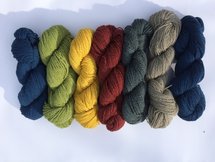 natural dyes are the best!
natural dyes are the best! The garden was bountiful this year, and I tried to put up as much as possible. It really cut into my wool processing, but I did manage to get some dyeing done, which was very gratifying. Our local yarn shop, Twisted Knitters, is selling almost everything I can produce!
Our biggest project this year is building a new shop to replace the one that burned in the fire two years ago. We went all out and decided to incorporate all the features that we wanted: covered storage and parking; enclosed, heated garage; workshop area; bathroom; office space; fiber workshop space; and a place for our walk-in cooler. The project started with bringing in fill dirt to build up the pad to a level that will allow the runoff to drain away. We hired our neighbor to do the foundation, framing and sheathing, and he got it all buttoned up before winter. Now we are doing the rest mostly ourselves. We got the septic tank in and covered up just before the ground froze, and are now working on electrical wiring. Hopefully we can get that inspected in a week or two, and then we can get some insulation in. We have the wood stove, so it will make it cozy for the finish work during the winter.
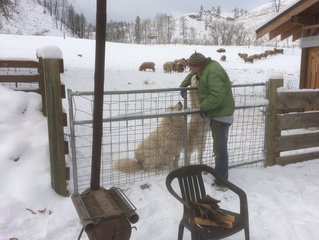 Bill with the newest generation of guard dogs
Bill with the newest generation of guard dogs Callie and Alfred are doing great. They play hard and are loving the snow. Alfred is so big now- we are guessing at least 130 lbs, maybe more. He has a sweet personality, and is very attentive to his guard duties. Last week I heard an eerie sound- something between a scream and a screech. I had no idea what it was, but Callie went tearing over to the fence line and barked ferociously for quite a while. Alfred stayed with the sheep. The next day I found some large cougar tracks in the snow, and I’m pretty sure that’s what I heard. Haven’t seen or heard any sign of it since. Our old dog Nellie is slowing down. She’s 10 years old now, and we are keeping her comfortable and providing a place out of the cold where she can live out her last days.
One of my resolutions for the New Year is to do better at updating the blog. We wish you all a happy holiday season, and stay tuned for more frequent updates in the New Year.

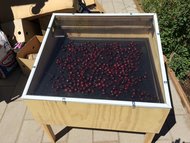
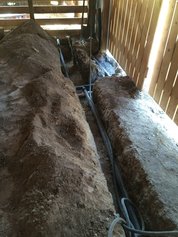
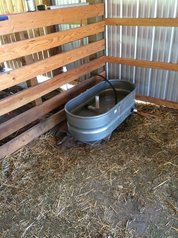
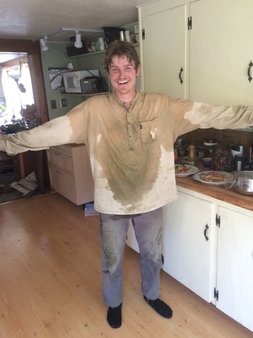
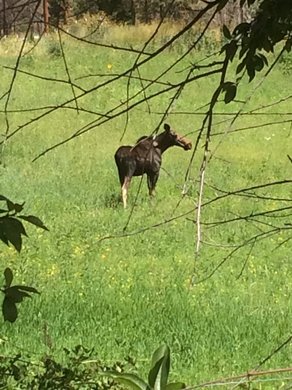
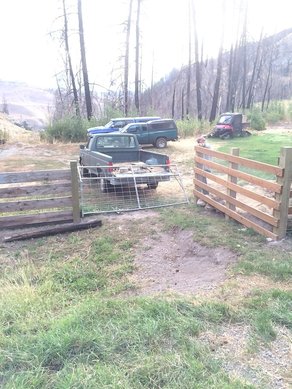
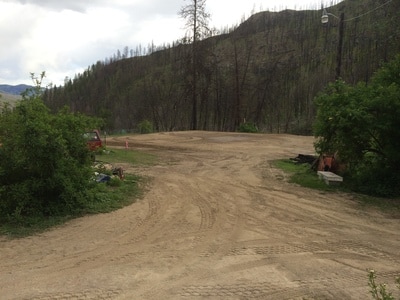
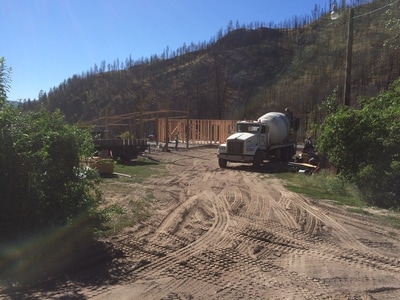
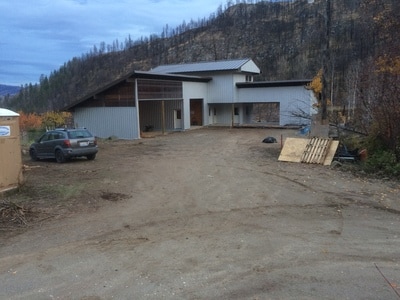
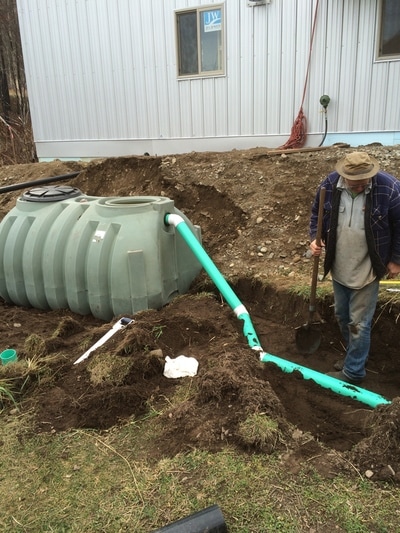
 RSS Feed
RSS Feed